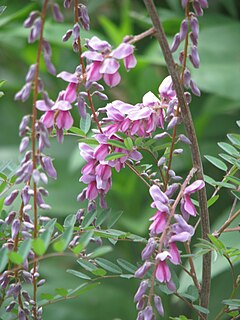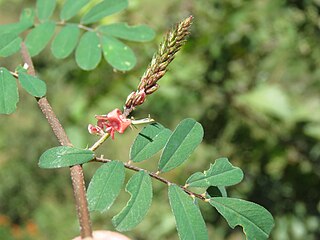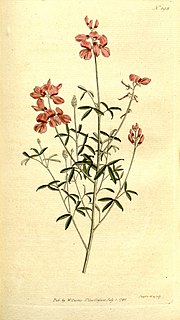
The Fabaceae or Leguminosae, commonly known as the legume, pea, or bean family, are a large and agriculturally important family of flowering plants. It includes trees, shrubs, and perennial or annual herbaceous plants, which are easily recognized by their fruit (legume) and their compound, stipulate leaves. The family is widely distributed, and is the third-largest land plant family in number of species, behind only the Orchidaceae and Asteraceae, with about 765 genera and nearly 20,000 known species.

Indigofera is a large genus of over 750 species of flowering plants belonging to the pea family Fabaceae. They are widely distributed throughout the tropical and subtropical regions of the world.
Indigofera marmorata is a species of legume in the family Fabaceae. It is found only in Yemen. Its natural habitats are subtropical or tropical dry forests and subtropical or tropical dry shrubland.
The Australian Plant Name Index (APNI) is an online database of all published names of Australian vascular plants. It covers all names, whether current names, synonyms or invalid names. It includes bibliographic and typification details, information from the Australian Plant Census including distribution by state, links to other resources such as specimen collection maps and plant photographs, and the facility for notes and comments on other aspects.

Pilea nummulariifolia is a perennial evergreen herbaceous plant commonly known as creeping charlie native to the Caribbean and northern South America. It can be grown indoors, for example in a hanging pot.

Indigofera decora, commonly known as summer wisteria, is a species of shrub native to China and Japan that has since been introduced to Australia and Sri Lanka. A member of the genus Indigofera, its family is Fabaceae and is used primarily for decorative purposes, though it has also been used to make indigo-colored dye.

Indigofera pendula, the weeping indigo, is a species of flowering plant in the family Fabaceae, native to south-central China. Its cultivar 'Shangri-la' has gained the Royal Horticultural Society's Award of Garden Merit.
Indigofera howellii is a species of flowering plant in the family Fabaceae, native to south-central China, Tibet, and Myanmar. Its cultivar 'Reginald Cory' has gained the Royal Horticultural Society's Award of Garden Merit.

Indigofera hirsuta, the hairy indigo or rough hairy indigo, is a species of flowering plant in the family Fabaceae. It is native to nearly all the world's tropics; South America, Africa, Madagascar, the Indian Subcontinent, southern China, southeast Asia, Malesia, Papuasia and Australia, and has been introduced to the Caribbean, the southeast United States, Mexico and Central America. It is used as a green manure and, to a minor extent, for forage.

Indigofera spicata, the creeping indigo or trailing indigo, is a species of flowering plant in the family Fabaceae. It is native to Sub‑Saharan Africa, Madagascar, Mauritius, Réunion, and Yemen, and has been introduced to the southeastern United States, various Caribbean islands, Brazil and other locations in Latin America, various Pacific islands, and New South Wales and Queensland in Australia. It was considered to be a promising forage plant, and then shown to be toxic to nearly all livestock, but it is possible that the experiments were conducted on the similar Indigofera hendecaphylla, leading to some confusion.

Indigofera hendecaphylla, the creeping indigo or trailing indigo, is a species of flowering plant in the family Fabaceae. It is native to the Old World Tropics and Subtropics, and has been introduced to various locales, including Japan and Australia. It was widely introduced as a forage plant when it was thought to be conspecific with Indigofera spicata, and then shown to be toxic to nearly all livestock, with some uncertainty as to which species was tested.

Indigofera linifolia, the narrowleaf indigo, is a species of flowering plant in the family Fabaceae. It is very widely distributed from Sudan eastwards to the Indian Subcontinent, Southeast Asia, Malesia, New Guinea and Australia, and it has been introduced to Réunion and New Caledonia. Livestock can consume it as fodder, and in times of famine humans can grind and bake the seeds into a bread. It grows on dry slopes, grasslands, and riversides.

Indigofera cassioides, the cassia indigo, is a species of flowering plant in the family Fabaceae. It is native to the Indian Subcontinent, Southeast Asia, southeast and south-central China, and Taiwan, and has been introduced to Sri Lanka and Kenya. Local artisans use its leaves to produce a blue dye.
Indigofera arrecta, variously called the Bengal, Java, or Natal indigo, is a species of flowering plant in the family Fabaceae. It is native to Sub‑Saharan Africa, the Arabian Peninsula, and Madagascar, and has been introduced to the Indian Subcontinent, Southeast Asia, some of the islands of Indonesia, the Philippines, and Queensland in Australia. Today it is occasionally used as a green manure, but historically was a major source of Indigo dye, with 600,000 hectares under cultivation in India in 1896, declining to a few thousand hectares 60 years later.

Indigofera hilaris, the red bush indigo or gay indigofera, is a species of leguminous shrublet in the genus Indigofera.

Indigofera amblyantha, the Chinese indigo or pink-flowered indigo, is a species of flowering plant in the family Fabaceae, native to central and southern China. A non‑climbing shrub reaching 6 ft (2 m), it blooms from May to September, and is recommended for hedges, borders, massing, and containers.

Indigofera kirilowii is a species of flowering plant in the family Fabaceae, native to eastern, central and northern China, the Korean Peninsula, and Kyushu island of Japan. A deciduous, suckering shrub typically 75 cm (30 in) tall, it is hardy in USDA zones 5 through 7. The unimproved species and a white‑flowered "alba" selection are commercially available.

Indigofera himalayensis, the Himalayan indigo, is a species of flowering plant in the family Fabaceae, native to the western Himalayas. A deciduous shrub reaching 1.5 m (5 ft), its 'Silk Road' cultivar is readily available in commerce.

Indigofera szechuensis is a species of flowering plant in the family Fabaceae, native to Tibet and central China. It is typically found growing on slopes, along trails, and on streambanks at 2,500–3,800 m (8,200–12,500 ft) above sea level. It is a non-climbing shrub reaching 2.5 m (8 ft).

Indigofera candicans, the white-leaved indigo, is a species of flowering plant in the family Fabaceae, native to the Cape Provinces of South Africa. The stems and the undersides of the leaves are white.
















